
Statue Square and Cenotaph / 1903
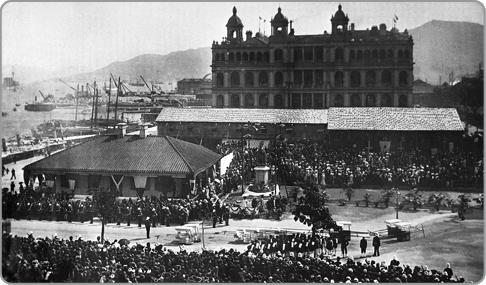
Queen Victoria's Statue at Statue Square
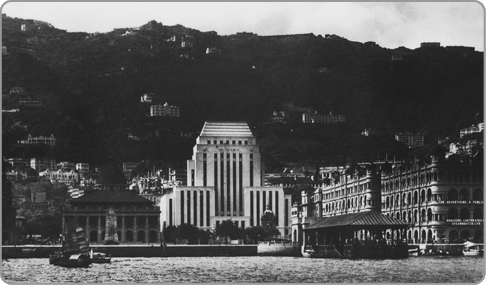
View of Cenotaph (centre), Statue Square (right) and Legislative Council (left) from the Victoria harbourfront
As new land to accommodate Central's vibrant commercial activities was needed, the Government put underway its second reclamation project in 1890, extending Hong Kong Island's shoreline from Des Voeux Road outwards to a shoreline marked by Connaught Road in 1903.
On this new land situated a good number of new buildings and monuments, including the current Legislative Council Building (former Supreme Court building), the Statue Square, the Prince's Building, the Mandarin Oriental Hong Kong (originally the site of the "Queen's Building"), The Hong Kong Club Building, and the HSBC Headquarters Building. These buildings are still standing in their original locations today.
The idea of a square of statues was conceived by Sir Catchick Paul Chater, a prominent businessman, as a dedication to the royalty of the great British Empire.
The Statue Square was the first and only civic space in the heart of Central. Construction was paid for by the HSBC with Crown Leases of 999 years. In 1901, the Government agreed not to build on either side of the Queen's statue and to keep the space forever as an open space.
A number of important persons' statues occupied the Square in the early days, including Queen Victoria (the statue, erected in 1896 to commemorate her Golden Jubilee, was moved to the Victoria Park after World War II), Prince Albert, Edward VII, and George V. The current statue still standing in the square, the statue of influential HSBC banker and longest serving Chief Manager in the Bank's early days, Sir Thomas Jackson, was erected in 1906. Many of these statues (including the HSBC bronze lions) were taken away by the occupying Japanese forces during World War II to be melted in Japan. Most were returned after the war.
The Statue Square space could be said to be most representative of Hong Kong. If one stands in the middle of the square and looks around, one can see many of the landmarks and icons of Hong Kong, and even glimpse into Hong Kong's history. These include financial institutions and major corporations that have played, and are still playing, a key role in Hong Kong's financial legacy (e.g. HSBC, Bank of China, and Standard Chartered Bank); the Legislative Council; all of Hong Kong's tallest buildings (e.g. Jardine House, Bank of China Tower, the IFC, and the ICC); three of Hong Kong's shorelines (i.e. Des Voeux Road, Connaught Road, and the new harbour front); buildings from Hong Kong's colonial past (e.g. Prince's Building, Mandarin Oriental Hong Kong, and the Cenotaph); and Hong Kong's first art and cultural hub, Hong Kong City Hall.
Even the square's users, a mix of locals and foreigners, make it uniquely Hong Kong. No other space in Hong Kong is comparable to the Statue Square's standing in these regards, and it remains to be one of the most popular public spaces in Hong Kong.

Queen Victoria's Statue at Statue Square

View of Cenotaph (centre), Statue Square (right) and Legislative Council (left) from the Victoria harbourfront

Statue Square and Cenotaph / 1923
As World War I came to an end, a Cenotaph was added to the northern side of the Statue Square in 1923 to commemorate the war dead.
The Cenotaph was a replica of the one designed by Sir Edwin Lutyen, a renowned British architect. The story went that in July 1919, Britain's Prime Minister, Lloyd George, commissioned Lutyen to design and produce a cenotaph for the Peace Celebrations, as a tribute to Britain's million dead soldiers in World War I. George gave Lutyens fourteen days to complete. Lutyens quickly sketched his design, which was accepted within six hours, and produced a wood and plaster structure within the timeframe given to him.
Lutyen's cenotaph became so popular that replica of the structure soon appeared throughout the United Kingdom. As of April 2002, 291 copies of this cenotaph had been erected all over the United Kingdom and its previous colonies. These cenotaphs vary in size and embellishments, with some having a soldier sleeping on top, some having a wreath, and others having a sword carved point-down on the side; but the core form remained the same.
Hong Kong's Cenotaph is almost exactly the same as the one that Lutyen made for the Whitehall in London. It was later used to commemorate also the war dead of World War II.
Ceremonies took place weekly at the Cenotaph, where there would be a change of flag at sunrise and sunset. Ceremonies were also performed annually on Liberation Day, the last Monday in August, to commemorate Hong Kong's liberation from Japanese occupation. These ceremonies ceased to be performed after the transition of Hong Kong’s sovereignty in 1997.
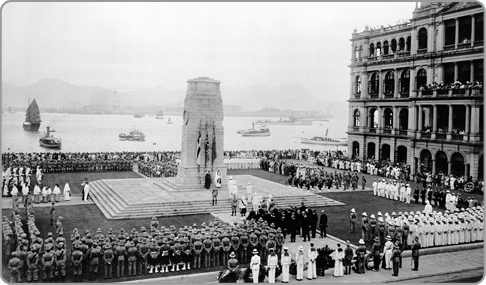
Cenotaph by the shore (before reclamation in the 1950s) and the old Hong Kong Club building (right)

Statue Square and Cenotaph / 1980
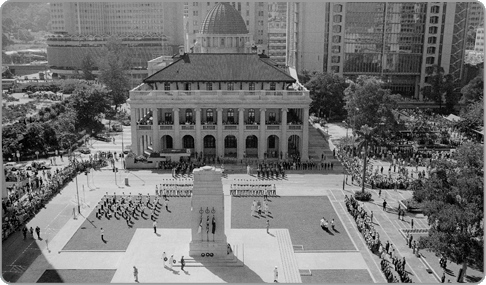
Cenotaph, with Legislative Council Building at the background, 1986
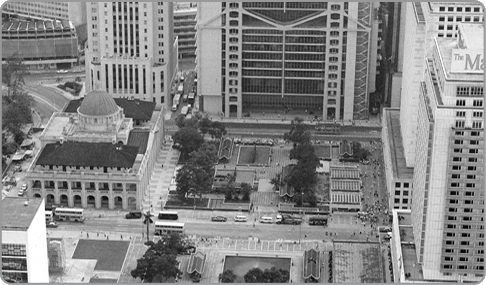
Statue Square on both sides of Chater Road
Today, workers in Central would come to Statue Square to have their lunch on weekdays, Filipino domestic helpers use the space to spend their Sundays, other locals would hold gatherings, festive celebrations, exhibitions, and all kinds of activities in this open space. The Statue Square cluster, including the Chater Garden, is also famous for being used as a space for public demonstration, for its close proximity to the Legislative Council and the Central Government Offices.
Since the 1980s, Central, especially the Statue Square, has attracted thousands of Filipino domestic helpers to gather on Sundays to meet and enjoy their day off. With most of the businesses closed and commercial activities at rest, Central provided much public space for these helpers to use. Picnics, gatherings with friends, singing and dancing, and even some Filipino-targeted businesses take place along the Central streets and flyovers. Chater Road is even closed to vehicles on Sundays for these activities.

Cenotaph, with Legislative Council Building at the background, 1986

Statue Square on both sides of Chater Road

Statue Square and Cenotaph / 2011
The Central Government Offices and the Legislative Council will move to a new location at the Tamar site in 2011. By then the uses and users of the Statue Square cluster might change. Demonstrations such as that toward the Express Rail may no longer be held here. What it will become exactly is left to be seen.

Statue Square and Cenotaph / Future
"Adaptation" or "adaptive re-use" refers to the act of revitalising or rejuvenating a building or an area through injecting new functions and activities into it. It can be done in many ways.





Statue Square and Cenotaph / Architectural Details
Concrete butterfly roofs of the pavilion
The roofs of the seating area were designed to be used as sun-shades, to catch rainwater, and to create pleasant spaces for resting and relaxing. These features, along with the water features, were not present in the original design and were only added later, by architect Chung Wah-nan.
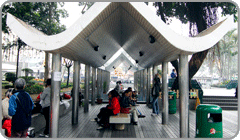
Water features
The water features in the Statue Square help to generate fresh air movement without the use of a windmill. Moving waters can keep space and materials cool in the summer and warm in the winter.
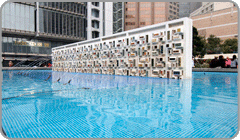










_EN_85x50.png)






















